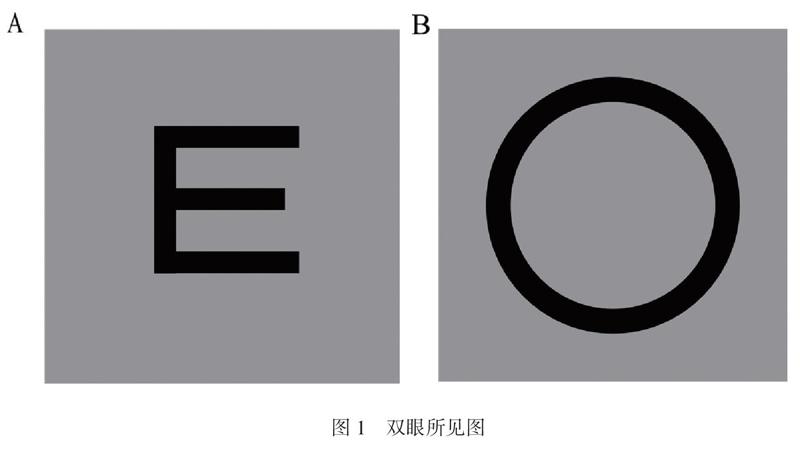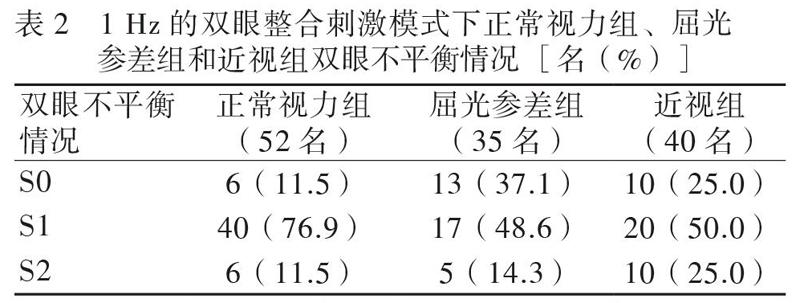非沉浸式虚拟现实平台下正常视力人群和屈光参差患者的双眼不平衡状态分析
2021-10-14罗汇慧姜志东林青梅徐莉
罗汇慧?姜志东?林青梅?徐莉



【摘要】目的 应用非沉浸式虚拟现实平台,探寻屈光参差和双眼不平衡情况的关系。方法 对体检人群中不同屈光状态的127名志愿者进行研究,检查其屈光状态和视功能(非沉浸式虚拟现实平台),记录和统计分析结果。结果 1 Hz频率的双眼整合刺激模式下,正常视力组与屈光参差组的双眼不平衡情况的差异均有统计学意义(P < 0.017),正常视力组中双眼不平衡(S1)的比例高于屈光参差组,单眼抑制(S2)的比例低于屈光参差组;而正常视力组和近视组、屈光参差组和近视组双眼不平衡情况差异均无统计学意义(P均> 0.017)。轻度屈光参差组和重度屈光参差组的双眼不平衡情况差异无统计学意义(P = 0.159)。结论 在非沉浸式虚拟现实平台的检查模式下发现屈光参差组和正常视力组双眼不平衡情况的构成有差异,屈光参差者中双眼严重不平衡的情况更多。
【关键词】双眼不平衡;屈光参差;双眼整合刺激模式
Assessment of binocular imbalance with a non-immersive virtual reality platform between emmetropes and anisometropes Luo Huihui, Jiang Zhidong, Lin Qingmei, Xu Li. Department of Cornea Ophthalmo-logy, Foshan Aier Eye Hospital, Foshan 528000, China Corresponding author, Xu Li, E-mail: xuli21315@ 163. com
【Abstract】Objective To explore the relationship between anisometropia and binocular imbalance by using a non-immersive virtual reality platform. Methods A total of 127 volunteers with different refractive status were recruited during physical examination. The refractive status and visual function (non-immersive virtual reality platform) were examined, and the results were recorded and statistically analyzed. Results Under the frequency of 1 Hz integrated binocular stimulation mode, the composition of binocular imbalance significantly differed among the normal vision and anisometropia groups (P < 0.017). The ratio of binocular imbalance in the normal vision group (S1) was higher, and the ratio of monocular suppression (S2) was lower than that of anisometropia group. The composition of binocular imbalance did not significantly differ between the normal vision, anisometropia and myopia groups (both P > 0.017). The composition of binocular imbalance did not significantly differ between the mild and severe anisometropia groups (P = 0.159). Conclusions Using the non-immersive virtual reality platform, the composition of binocular imbalance significantly differs between the anisometropia and normal vision counterparts. The incidence of binocular imbalance is higher in anisometropia patients.
【Key words】Binocular imbalance;Anisometropia;Integrated binocular stimulation mode
屈光参差被认为是在等效球镜(Se)≥1.00 D的双眼屈光差。屈光参差引起的双眼视功能异常会对患者的生活和工作产生极大的影响[1-2]。双眼视知觉中的双眼不平衡状态为知觉在双眼呈现的不同刺激图像间竞争,表现为观察者看到2个图像交替出现[3]。本课题组前期通过回顾性调查发现不同程度的雙眼不平衡在正常视力者(双眼裸眼视力≥0.8且无眼疾)中占有很大比例,且可能会让双眼交替间歇使用[4]。但双眼不平衡情况与屈光参差的关系有待进一步探索。本研究收集体检人群中不同屈光状态的志愿者,使用频率为
1 Hz的双眼整合刺激模式对其双眼不平衡的情况进行测量,探寻屈光参差和双眼不平衡情况的关系,为临床探寻屈光参差的发生和进展机制提供新的思路。
对象与方法
一、研究对象
视觉系统的物理成份和神经成份协同工作来形成我们“感知”的图像,物理成份可捕获物像的某些细节,但人们“感知”的图像可能不完全是眼睛捕获的东西,神经成份的有效表现能增强图像,但神经成份的缺陷会扭曲或摧毁这些细节。视觉传导系统中的大细胞系统主要传导运动信息和低对比度黑白信息(小细胞系统传导颜色和高对比度黑白细节的信息)[15]。课题组采用1 Hz频率抖动的检查标图像(E视标和圆圈)来检测双眼对运动信息的处理情况后发现,虽然正常视力组、屈光参差组与近视组双眼不平衡情况的平均分布位置差异无统计学意义,但屈光参差组中S2的构成高于正常视力组,由此推测屈光参差可能与大细胞通路(负责运动信息传递)功能缺陷相关。正常视力组中绝大部分的志愿者表现为双眼不平衡,从双眼不平衡的表现过程和其在正常视力人群中普遍存在的这个现象中推测,双眼视知觉中的双眼不平衡可能会让双眼间歇、交替使用,能更好的表现出双眼间使用的协调性,有助于减轻视疲劳[4, 16]。屈光参差组中,轻度屈光参差组和重度屈光参差组的双眼不平衡情况的构成情况差异无统计学意义,可推测大细胞通路的缺陷可能和屈光参差的进展关系不大。但因屈光参差组的样本量尤其是重度屈光参差的样本量偏小,这个结论有待以后扩大样本量作进一步的验证。
综上所述,双眼视知觉中的双眼不平衡情况在人群中普遍存在且可能会让双眼交替间歇使用。屈光参差组中的双眼严重不平衡更多,由此可以推测大细胞通路(传输运动信息)的缺陷与屈光参差发生有关,与其进展关系可能不大,但其中的具体关联性还需要更进一步扩大样本量的临床实验证实。
参考文献
[1] Smith EL 3rd, Hung LF, Arumugam B, Wensveen JM, Chino YM, Harwerth RS. Observations on the relationship between anisometropia, amblyopia and strabismus. Vision Res,2017,134:26-42.
[2] Deng L, Gwiazda JE. Anisometropia in children from infancy to 15 years. Invest Ophthalmol Vis Sci,2012,53(7):3782-3787.
[3] 王育良, 張传伟, 闫丽.脑视觉.北京:人民军医出版社,2013:204-205.
[4] 徐莉, 蓝剑青, 潘羽蔚, 罗琨, 褚航, 阎丽, 曾锦.正常视力人群在不同时空频率的双眼整合刺激模式下的双眼视功能.中国斜视与小儿眼科杂志,2019,27(3):8-11.
[5] 赵堪兴, 杨培增.眼科学.8版.北京:人民卫生出版社,2013:246-249.
[6] 李娟, 郭海科, 曾锦, 谢文娟, 李仲明, 欧碧群, 廖伟雄.双眼屈光参差中眼轴、角膜屈光力与屈光度差值的相关性研究.新医学,2013,44(3):202-205.
[7] 付晶, 卢炜, 吴殿鹏, 褚航, 阎丽.斜视与弱视患者精细与粗糙立体视的研究.中国斜视与小儿眼科杂志,2015,23(1):1-5.
[8] 徐莉, 庞莎莎, 褚航, 阎丽, 曾锦.近视者双眼不平衡的临床观察.临床医学工程,2020,27(9):1157-1158.
[9] 冯成志, 贾凤芹.双眼竞争研究现状与展望.心理科学进展,2008,16(2):213-221.
[10] Wang J, Feng L, Wang Y, Zhou J, Hess RF. Binocular benefits of optical treatment in anisometropic amblyopia. J Vis,2018,18(4):6.
[11] Hess RF, Thompson B. Amblyopia and the binocular approach to its therapy. Vision Res,2015,114:4-16.
[12] Vera-Diaz FA, Bex PJ, Ferreira A, Kosovicheva A. Binocular temporal visual processing in myopia. J Vis,2018,18(11):17.
[13] Nabie R, Andalib D, Khojasteh H, Aslanzadeh SA. Comparison of the effect of different types of experimental anisometropia on stereopsis measured with Titmus, Randot and TNO stereotests. J Ophthalmic Vis Res,2019,14(1):48-51.
[14] Nabie R, Andalib D, Amir-Aslanzadeh S, Khojasteh H. Effect of artificial anisometropia in dominant and nondominant eyes on stereoacuity. Can J Ophthalmol,2017,52(3):240-242.
[15] Cadet N, Huang PC, Superstein R, Koenekoop R, Hess RF. The effects of the age of onset of strabismus on monocular and binocular visual function in genetically identical twins. Can J Ophthalmol,2018,53(6):609-613.
[16] Xu L, Huang M, Lan J, Huang W, Wang X, Zhang G, Li X, Shasha P, Chu H, Wiederhold BK, Wiederhold M, Yan L, Yang X, Zeng J. Assessment of binocular imbalance with an augmented virtual reality platform in a normal population. Cyberpsychol Behav Soc Netw,2019,22(2):127-131.
(收稿日期:2020-11-20)
(本文编辑:郑巧兰)
